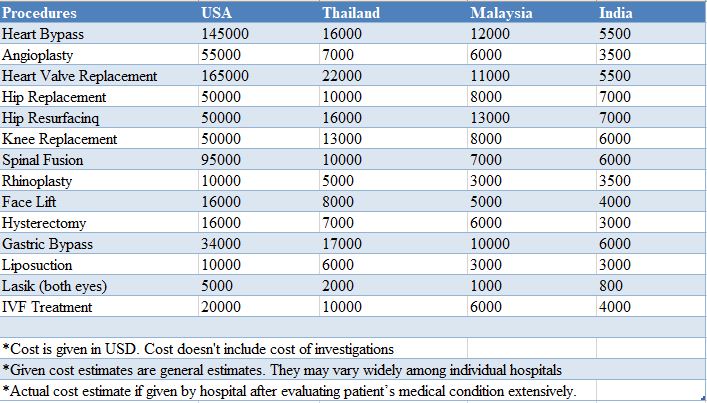India is the most preferred medical travel destination for patients from South Asia, Africa, GCC, CIS and even parts of Europe, North America and Australia. Here are the top reasons why India is a preferred destination for Medical Travelers
Because it is best affordable option in South Asia.
Let’s face it. Americans and Europeans are not the major travelers to India. India is the first choice of medical travel for patients from Bangladesh, Oman, Iraq, UAE, Nigeria, Kenya, Ethiopia etc. For these countries, India is the closest country where they can get world class treatment at a relatively affordable budget when we compare to other medical tourism destinations like US, Europe, Singapore, Thailand etc.
Cultural Similarity
For a patient from South Asia, GCC Countries, Africa or CIS countries, India is much more culturally closer than other medical tourism destinations. Hence, patients feel much at home when traveling to India, than in other countries.
Medical Expertise
Thanks to the vision of the founding leaders of the country, despite having achieved independence relatively late (in 1947) and despite being a poor country, India gave good priority to scientific and medical education. As a result, premier institutions such as the All India Institute of Medical Sciences (est. 1956), Armed Forces Medical College, Pune (1948) etc were established. Also, existing colleges like Calcultta Medical College, Madras Medical College etc were supported and enhanced. As a result, the country has produced high number of qualified medical graduates and post-graduates who, over the next several decades, have helped bring enormous enormous medical skills. Today, doctors from India are known for their expertise all across the world and are at leading positions in hospitals in every corner of the world.
The growth of the Private Sector in Healthcare
One of the most remarkable reasons for the growth of medical tourism in India is the growth of privately owned world-class super-specialty hospitals. As a resource poor country, the Govt. Hospitals in India lack adequate infrastructure and equipments, poor management of public hospials have also been a great issue. The growth of private hospitals began in the 1980s and peaked in the 1990s & 2000’s when India began to open up its market to the world. The pioneer hospital in private healthcare was the Chennai-based Apollo Hospital founded by Dr. Pratap Chandra Reddy. Gradually, many other private corporate groups were set up. As a result of growth of Private Corporate Hospitals like Apollo Hospitals, Max Healthcare, Medanta, BLK Super Specialty Hospital, Kokilaben Dhirubhai Ambani Hospital etc, India got an abundant number of hospitals that not just had the most expert medical specialists, but also got world-class infrastructure. Also, these healthcare providers began marketing their services globally, thereby attracting medical tourists to India for all over the world.
Affordability

Hospitals in India are able to offer a discounted reason primarily for the following reasons:
Discounted land provided to many private hospitals
Many Hospitals have received land grants from the govt at subisidised rate on commitment of treating certain percentage of economically weaker sections. This helped them save a good amount of money on cost of land acquistion
Abundant supply of skilled doctors
Thanks to its democratic advantage with almost half of the population at young age and medical colleges churning out over 30,000 medical graduates every year, hospitals are able to find talented doctors at relatively low cost. This helps keep the overall cost of treatment low compared to the hospitals in developing countries.
Drugs manufactured locally & cheaper
Another major cost advantage that Indian healthcare gets, is the availability of medicines at a fraction of the cost of what is available in developed countries. India accounts for over 20% of generic drugs globally making it the world’s largest drug exporter. The Pharmaceutical Industry of India was valued at $33 billion as early as 2017. Since cost of medicines account for a good percentage of overall treatment cost, patients get a good reprieve in terms of medicine costs when they come for treatment in India.
Cheaper travel & accommodation
Hotels & local travel are also cheaper in India compared to countries of US or Europe and hence, helps in reducing total expenses associated with treatment abroad.
Little or no language barrier
English is spoken widely in India. Most of the hospitals staff can speak fluent English. In addition, all the top private hospitals have foreign language interpreters for languages such as Arabic, Bengali, Russian, French, Uzbek etc. Thus, patients do not face language barriers and get treatment done and experience the country without hassle.
High NRI Population
Alternative Medicine
Much before the development of Allopathy medicines, India was a global hub of Ayurveda. Also, India is considered the birthplace of Yoga. Thus, India gets high number of patients for alternative treatment, yoga and meditation. Many patients also prefer to spend some time in a yoga & meditation resort after completion of treatment for holistic healing after their medical treatment.

